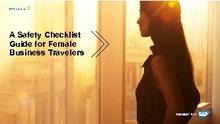Why is Business Travel Safety Different for Women?
It may come as no surprise that 71% of female business travelers believe they face greater risk than their male counterparts. This is according to a 2018 online survey conducted by AIG Travel Inc. and Global Business Travel Association (GBTA) of women who traveled on four or more business trips within the past year. Of the women surveyed, 83% experienced a safety related event within that year, and 80% said those events impacted their work productivity. This makes sense, right? If we feel unsafe or threatened—the human response is to protect ourselves, making it difficult to give 100% focus to the business objective at hand.

It’s not just the insurance industry trying to understand the degree of risk to female business travelers (and all travelers for that matter), its companies of every size that are required to protect their traveling employees with something called duty of care policy. Duty of care policy responsibilities span multiple departments, including human resources, corporate travel, security, and legal. A lot of companies have policies in place yet may not have updated them to reflect their growing population of female travelers in today’s uncertain global environment.
In my own experience as a female business traveler, I can guarantee that if you sat down any group of female business associates, it’s likely every single one could tell a story or two about a safety incident that’s happened to them while traveling on business—whether to a convention in the next city or a business trip half way around the world. Safety incidents can include food and health risks, information security risks, natural disasters or even terrorist events. But the stories I hear most often are about sexual harassment and assault, theft, and cultural travel issues.

And yet, fewer than 50% of women report personal safety incidents to their organizations, according to the AIG Travel, Inc. and GBTA survey. Brittany Lewis, security operations analyst at AIG Travel, said in a panel discussion at the August 2018 GBTA convention that she believes this may have to do with women not wanting to be perceived as weak or vulnerable within their organizations. Or, that by reporting an incident, it might limit their opportunities for more business travel which could impact their career or promotional track.
It’s complicated from all sides. And companies today face more pressure than ever to ensure the safety of all their travelers. A recent GBTA Foundation survey, sponsored by SAP Concur, found 43% of travel managers say that in the event of an emergency, they can locate all their employees in the affected area within two hours or less. In fact, 34% of travel managers say they do not know how long it would take to locate their affected employees in a crisis situation. There’s a gap here and for female business travelers, we need to learn how to avoid putting ourselves into unsafe situations as well as how to best respond if an incident does occur.
As part of this four-part blog series on business travel safety for women, my goal is to arm you with trusted, resource-rich information to help you become a more street smart, tech savvy, and informed business traveler. Even if your company has duty of care policies in place and you receive company training on travel safety, I’ve learned from personal experience that it’s always worth it to self-educate.

